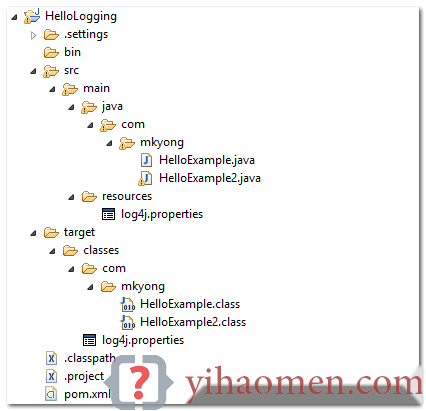Log4j hello world example
In this tutorial, we will show you how to use the classic log4j 1.2.x to log a debug or error message in a Java application.
1. Project Directory
Review the final project structure, a standard Maven style Java project.

2. Get Log4j
Declares the following dependencies :
<dependency> <groupId>log4j</groupId> <artifactId>log4j</artifactId> <version>1.2.17</version> </dependency>
For non-Maven user, visit log4j official page, download the jar and put it in the project library path manually.
3. log4j.properties
Create a log4j.properties file and put it into the resources folder. Refer to the step #1 above.
- For standalone Java app, make sure the log4j.properties file is under the project/classes directory
- For Java web applications, make sure the log4j.properties file is under the WEB-INF/classes directory
# Root logger option
log4j.rootLogger=DEBUG, stdout, file
# Redirect log messages to console
log4j.appender.stdout=org.apache.log4j.ConsoleAppender
log4j.appender.stdout.Target=System.out
log4j.appender.stdout.layout=org.apache.log4j.PatternLayout
log4j.appender.stdout.layout.ConversionPattern=%d{yyyy-MM-dd HH:mm:ss} %-5p %c{1}:%L - %m%n
# Redirect log messages to a log file, support file rolling.
log4j.appender.file=org.apache.log4j.RollingFileAppender
log4j.appender.file.File=C:\\log4j-application.log
log4j.appender.file.MaxFileSize=5MB
log4j.appender.file.MaxBackupIndex=10
log4j.appender.file.layout=org.apache.log4j.PatternLayout
log4j.appender.file.layout.ConversionPattern=%d{yyyy-MM-dd HH:mm:ss} %-5p %c{1}:%L - %m%n
To understand the symbols in the ConversionPattern, please refer to this log4j PatternLayout guide.
Let break it down :
- %d{yyyy-MM-dd HH:mm:ss} = Date and time format, refer to SimpleDateFormat JavaDoc.
- %-5p = The logging priority, like DEBUG or ERROR. The -5 is optional, for the pretty print format.
- %c{1} = The logging name we set via getLogger(), refer to log4j PatternLayout guide.
- %L = The line number from where the logging request.
- %m%n = The message to log and line break.
Log message examples :
2014-07-02 20:52:39 DEBUG className:200 - This is debug message 2014-07-02 20:52:39 DEBUG className:201 - This is debug message2
4. Demo – How to log a Message?
To log a message, first, create a final static logger and define a name for the logger, normally, we use the full package class name.
final static Logger logger = Logger.getLogger(classname.class);
Then, logs messages with different priorities, for example, debug, info, warn, error and fatal. Normally, you just need to use debug or error.
//logs a debug message
if(logger.isDebugEnabled()){
logger.debug("This is debug");
//logs an error message with parameter
logger.error("This is error : " + parameter);
//logs an exception thrown from somewhere
logger.error("This is error", exception);
4.1 Example : Logger is set to debug priority.
log4j.rootLogger=DEBUG, stdout #...
package com.mkyong;
import org.apache.log4j.Logger;
public class HelloExample{
final static Logger logger = Logger.getLogger(HelloExample.class);
public static void main(String[] args) {
HelloExample obj = new HelloExample();
obj.runMe("mkyong");
private void runMe(String parameter){
if(logger.isDebugEnabled()){
logger.debug("This is debug : " + parameter);
if(logger.isInfoEnabled()){
logger.info("This is info : " + parameter);
logger.warn("This is warn : " + parameter);
logger.error("This is error : " + parameter);
logger.fatal("This is fatal : " + parameter);
Output
2014-07-02 20:52:39 DEBUG HelloExample:19 - This is debug : mkyong 2014-07-02 20:52:39 INFO HelloExample:23 - This is info : mkyong 2014-07-02 20:52:39 WARN HelloExample:26 - This is warn : mkyong 2014-07-02 20:52:39 ERROR HelloExample:27 - This is error : mkyong 2014-07-02 20:52:39 FATAL HelloExample:28 - This is fatal : mkyong
4.2 Example – Logger is set to error priority.
log4j.rootLogger=error, stdout #...
Run the HelloExample again, you will get the following output
2014-07-02 20:56:02 ERROR HelloExample:27 - This is error : mkyong 2014-07-02 20:56:02 FATAL HelloExample:28 - This is fatal : mkyong
Review the log4j’s Priority class.
package org.apache.log4j;
public class Priority {
public final static int OFF_INT = Integer.MAX_VALUE;
public final static int FATAL_INT = 50000;
public final static int ERROR_INT = 40000;
public final static int WARN_INT = 30000;
public final static int INFO_INT = 20000;
public final static int DEBUG_INT = 10000;
//public final static int FINE_INT = DEBUG_INT;
public final static int ALL_INT = Integer.MIN_VALUE;
If priority is defined in log4j.properties, only the same or above priority message will be logged.
5. Demo – How to log an Exception
An example to show you how to use log4j to log an exception.
package com.mkyong;
import org.apache.log4j.Logger;
public class HelloExample2{
final static Logger logger = Logger.getLogger(HelloExample2.class);
public static void main(String[] args) {
HelloExample2 obj = new HelloExample2();
try{
obj.divide();
}catch(ArithmeticException ex){
logger.error("Sorry, something wrong!", ex);
private void divide(){
int i = 10 /0;
Output
2014-07-02 21:03:10 ERROR HelloExample2:16 - Sorry, something wrong! java.lang.ArithmeticException: / by zero at com.mkyong.HelloExample2.divide(HelloExample2.java:24) at com.mkyong.HelloExample2.main(HelloExample2.java:14)
Done.
References
- log4j 1.2 official page
- log4j pattern layout
- Wikipedia : log4j
- Spring MVC + log4j example
- log4j.properties examples
From:一号门
Previous:servlet-api-2.5.jar jar not loaded

COMMENTS